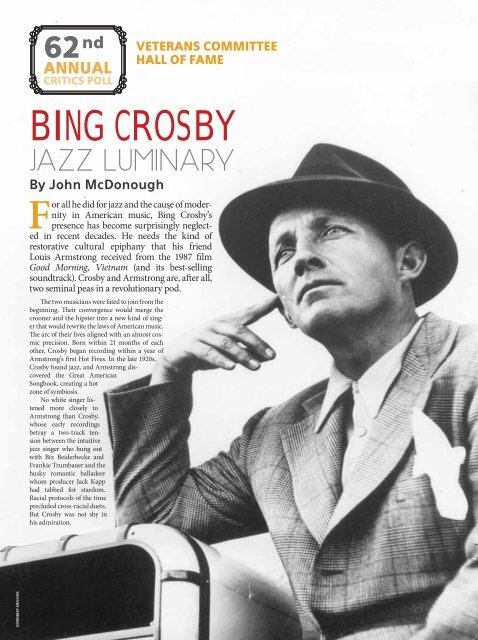Create successful ePaper yourself
Turn your PDF publications into a flip-book with our unique Google optimized e-Paper software.
62 nd<br />
ANNUAL<br />
CRITICS POLL<br />
VETERANS COMMITTEE<br />
HALL OF FAME<br />
BING CROSBY<br />
JAZZ LUMINARY<br />
By John McDonough<br />
For all he did for jazz and the cause of modernity<br />
in American music, Bing Crosby’s<br />
presence has become surprisingly neglected<br />
in recent decades. He needs the kind of<br />
restorative cultural epiphany that his friend<br />
Louis Armstrong received from the 1987 film<br />
Good Morning, Vietnam (and its best-selling<br />
soundtrack). Crosby and Armstrong are, after all,<br />
two seminal peas in a revolutionary pod.<br />
The two musicians were fated to join from the<br />
beginning. Their convergence would merge the<br />
crooner and the hipster into a new kind of singer<br />
that would rewrite the laws of American music.<br />
The arc of their lives aligned with an almost cosmic<br />
precision. Born within 21 months of each<br />
other, Crosby began recording within a year of<br />
Armstrong’s first Hot Fives. In the late 1920s,<br />
Crosby found jazz, and Armstrong discovered<br />
the Great American<br />
Songbook, creating a hot<br />
zone of symbiosis.<br />
No white singer listened<br />
more closely to<br />
Armstrong than Crosby,<br />
whose early recordings<br />
betray a two-track tension<br />
between the intuitive<br />
jazz singer who hung out<br />
with Bix Beiderbecke and<br />
Frankie Trumbauer and the<br />
husky romantic balladeer<br />
whom producer Jack Kapp<br />
had tabbed for stardom.<br />
Racial protocols of the time<br />
precluded cross-racial duets.<br />
But Crosby was not shy in<br />
his admiration.<br />
DOWNBEAT ARCHIVES


